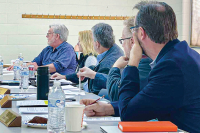Art partnership: Swain County couple Dee Dee and Robert Triplett share a love for creating and sharing one-of-a-kind art pieces
By Michael Beadle
Dee Dee Triplett is a woman of the cloth. Her husband, Robert, is a man of strong metal.
While Dee Dee creates whimsical dolls like dancing bears and cat people, Robert pounds copper sheets into decorative fountains and bowls.
Though gifted with vastly different art forms, the two share a love of making art and teaching what they know. As members of the Southern Highlands Craft Guild (Robert being one of its current board members), they have become widely respected in craft circles across the country. As long-time teachers at the John C. Campbell Folk School, they are eager to share their wealth of knowledge for the next generation of craft artists.
In their two-story cabin perched in the sylvan mountains outside Bryson City, the Tripletts enjoy a quiet respite after moving around the country for decades.
It’s taken a few months for Dee Dee to tidy up her loft studio after completing her associate’s degree. What was once a mess too embarrassing for strangers to see is now a cozy work space. Shelves packed with books line the walls up the staircase. Dolls pose in dancing positions atop the shelves, desks, and a work table. Assorted fabrics have been stacked and stowed with magazines and materials — anything that might come in handy for the next project.
Related Items
“I see possibilities in anything,” she says, and that makes it impossible to throw away anything.
Dee Dee once produced how-to instructions for needlecraft and fabric projects for magazines like Better Homes and Gardens. Then cross stitching turned into doll making. One of her dolls, a jester balancing on a ball, graced the cover of Art Doll Quarterly magazine. She has sent ornament dolls to hang on two White House Christmas trees – once in 1993 and again in 1999.
Robert, meanwhile, works in a shop down the hill from their house. He has metalsmithed creations all over the country — a birdfeeder in Highlands, giant wheat grains in an Illinois church, a frying pan in Georgia, a stove hood in South Carolina. At home, pieces like an amber-tinted copper bowl and a spiral that swirls in the pattern of a Fibonacci sequence offer examples of how a master manipulates metal.
Both Dee Dee and Robert were raised in small towns with parents who sewed, made jewelry, carved wood and taught their children that if you wanted something you had to make it.
Robert says his father also taught him a great deal about all things mechanical, from lawn mowers to cars. His mother showed similar ingenuity around the house, from gardening to canning and freezing vegetables. Robert, without realizing it, absorbed their pragmatic skills, rebuilding the engine and body on a 1930 Model A Ford before he finished the eighth grade.
“I think we both had a great respect for our parents’ knowledge and wisdom. However, we did not realize that until we were in our twenties,” Robert said.
While Robert turned out to be an engineer — “He has a calculator between his ears,” Dee Dee declares — he also has the gift of helping people achieve their own vision, showing people how to come up with an individual piece and then carrying the artist through to its completion. Art, for Robert, is both a concept and a process, the imagining and the getting it done.
The Tripletts met in Dee Dee’s hometown of Brookneal, Va. Robert, who grew up in Eastern North Carolina, completed college at North Carolina State University and took a job as an electrical engineer with Burlington Industries. Rather than sign on with DuPont or General Motors, Robert figured he could fit in better with a smaller company. So, once he showed up to work at a dyeing and finishing plant in Dee Dee’s small town, he became infatuated with the lifeguard at the pool.
“She was a gorgeous girl who was fun to go out with, had a good sense of humor and was very talented in areas that were different from my talents,” said Robert.
Dee Dee’s neighbors encouraged her to get to know this good-looking, red-headed stranger.
Those neighbors must have been right about something. The two met in April and were married by January. After some 38 years of marriage and living in six different houses, they still steal that occasional twinkly-eyed glance as if they were teen-agers all over again.
Built to last
As Robert climbed the ladder from engineer to supervisor to plant engineer (he’s now the engineering manager for Harrah’s Casino in Cherokee), the family moved to South Carolina, North Carolina, back to South Carolina, then Texas, then back to South Carolina and finally Western North Carolina where they’ve lived since 1994. In the late ‘70s, Robert had been a woodworker making furniture as a hobby. Looking for something new, he took a weekend blacksmithing class at an art museum in Greenville, S.C., under the direction of Francis Whitaker, a teacher who Robert would later come to know as the man responsible for a major resurgence in blacksmithing in the United States.
There was something about the art form that intrigued Robert. He began researching the history of blacksmithing and metalwork. Before factories made millions of identical parts, there were blacksmiths who had to hammer heat and cool metal into tools, pots, pans, utensils, handles, all sorts of things we take for granted today. There was a pride in craftsmanship, a great value given to hand-crafted things. Nowadays, Robert says, machines are built to be replaced instead of repaired.
“I think we’ve lost a lot in that process,” Robert says.
The first metal piece Robert made was a holder to swing a pot over a fireplace. Simple, utilitarian and built to last. The engineer in him saw more designs. After taking classes at the John C. Campbell Folk School in Brasstown, he began assisting the teacher in the silversmithing classes, which lead to him eventually teaching his own classes in the art of coppersmithing. Rather than giving his students cookie-cutter designs, he tries to impart techniques that the individual can use to design a personal piece.
“I’m not going to give them a pattern,” he says.
Taking a flat piece of copper, a 12-inch by 12-inch square, he’ll hammer it into the shape of a bowl. But this hardens and stresses the copper to the point it might break, so it has to be annealed, a process of heating and cooling the metal so that it will allow the molecules to relax and endure the pounding.
Once the artist taps out the surface, it will have lots of dimples. The piece is put in an acid to clean it and then heated (350-550 degrees Fahrenheit for a bright luster, 900 degrees for a darker look).
Since it can be an exhausting process, the blacksmithing that Robert teaches his students at John C. Campbell takes a week and a weekend. The Sunday through Sunday class might take longer than some classes, but Robert has learned to ease away from those projects that push into late night.
For students and beginners who are just trying to get the hang of hammering out metal into a bowl, Robert lends a bit of Zen-like advice: “Don’t worry about making art. Just make a bowl.”
Art from the heart
While Robert pounds away in the heat of a blacksmithing forge, Dee Dee gets into a dreamy spell putting together her latest art doll – faceless, elegant figures that become jesters, dancers, bears, or multi-armed creatures she labels “Armed and Dangerous.”
Playful in their fixed gestures, they look like they might twist into a new pose when you’re not looking. And perhaps they do.
“They move just before you see them,” she jokes.
Just as her husband found his passion with a metalsmith mentor, Dee Dee discovered her love of doll making through doll-making artist — Lenore Davis — while attending an art show in Greenville, S.C. Dee Dee studied under Davis and took her career in fabric art to a whole new place.
“That just blew me away,” Dee Dee recalls. “She was my first inspiration.”
From Davis, all sorts of dolls came to mind — animals, fantastical creatures, wood sprites, dancers, cat people. Some were given titles befitting an oil painting — “Twilight Casting Reflections on a Night Sky” or “Mysteries.”
“Basically, I want people to smile,” she says. “I refuse to participate in angsty art.”
Each doll becomes a manifestation of her personality, like characters in fiction that resemble the real people we encounter. For Dee Dee, it’s about sharing these characters in a story. With some dolls, she’ll even do research to come up with an appropriate name and background story. Of course, as with any art form, there are botched attempts, fabric disasters, messes to be made.
“You can only learn by messing up,” she says.
Given the Tripletts’ knack for creativity, could there be a joining of the two art forms in the future?
Dee Dee leaves the idea open.
It’s trickier to shape metal than to sew with fabric, she admits.
Robert made a copper leaf chair for one of Dee Dee’s dolls.
Who knows — maybe the next bear doll will find a copper bowl of honey.









